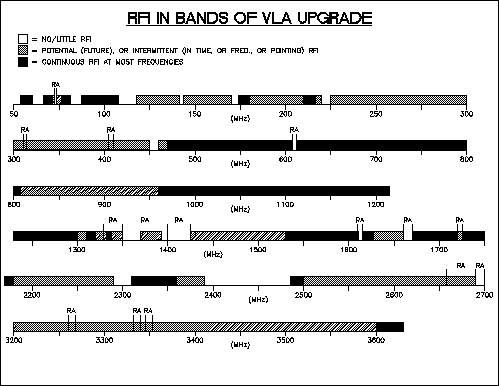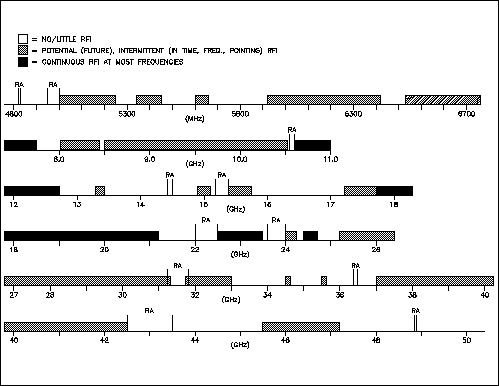
Figure 5.7: Potential for RFI in the Enhanced VLA Bands

Figure 5.7: Potential for RFI in the Enhanced VLA Bands

Figure 5.8: Potential for RFI in the Enhanced VLA Bands
An important consideration for the VLA Development Plan is the reality of radio frequency interference (RFI). The desire to upgrade the VLA to wide-bandwidth performance (of order 1 GHz per polarization channel) means that the instrument will often operate outside of the protected frequency bands. The array will therefore be susceptible to RFI to a even higher degree than it is now, especially at frequencies below a few GHz. It is unfortunately safe to assume that the RFI environment will be significantly worse when the VLA Development Plan is completed than it is now.. This results from the accelerating demand for mobile personal communications systems and from the fact that several areas of spectrum, previously lightly used and under the control of the Federal Government, are being transferred to the control of the FCC. It is essential that all equipment be designed with requirements for detection, rejection and excision of RFI in mind.
Some general statements, based on frequency allocation tables and
preliminary RFI monitoring at the VLA site, can be made about likely
RFI in the proposed enhanced VLA bands. Figs. 5.7 and 5.8 show
the expected RFI problems for each band. Between  MHz it
seems unlikely that the wide-band low-noise amplifiers in a receiver
covering this frequency range will be driven into compression by
RFI. It will be essential, however, to provide filtering after the
first 20-30 dB gain low-noise amplifier to prevent compression further
downstream in the receiver electronics chain. This filtering should
take the form of either a tunable bandpass filter or a number of
switchable bandpass filters which pass only those frequency ranges
needed for the observation and known to be relatively free of RFI. The
selection of the filters and observing frequency range would be made
on the basis of data provided by an RFI monitoring system to be
located at the VLA site. Between 800-1200 MHz, the same remarks
apply. The frequency range 840-920 MHz may become particularly
difficult to use because of the proliferation of cellular telephones
(except possibly for a short period late at night). The frequency
range 960-1220 MHz will be problematic due to its allocation to
aeronautical navigation uses. Between 1200-1750 MHz, it is unclear
whether or not the filtering scheme proposed for the lower bands will
be needed, but the possibility of installing it in the future should
certainly be included in the design. There will almost certainly be
unusable frequency ranges such as 1610-1627 MHz which is assigned to
the mobile satellite service for which constellations of satellites
totaling hundreds of elements in orbit are proposed. For the bands
MHz it
seems unlikely that the wide-band low-noise amplifiers in a receiver
covering this frequency range will be driven into compression by
RFI. It will be essential, however, to provide filtering after the
first 20-30 dB gain low-noise amplifier to prevent compression further
downstream in the receiver electronics chain. This filtering should
take the form of either a tunable bandpass filter or a number of
switchable bandpass filters which pass only those frequency ranges
needed for the observation and known to be relatively free of RFI. The
selection of the filters and observing frequency range would be made
on the basis of data provided by an RFI monitoring system to be
located at the VLA site. Between 800-1200 MHz, the same remarks
apply. The frequency range 840-920 MHz may become particularly
difficult to use because of the proliferation of cellular telephones
(except possibly for a short period late at night). The frequency
range 960-1220 MHz will be problematic due to its allocation to
aeronautical navigation uses. Between 1200-1750 MHz, it is unclear
whether or not the filtering scheme proposed for the lower bands will
be needed, but the possibility of installing it in the future should
certainly be included in the design. There will almost certainly be
unusable frequency ranges such as 1610-1627 MHz which is assigned to
the mobile satellite service for which constellations of satellites
totaling hundreds of elements in orbit are proposed. For the bands
 GHz there should be fewer cases in which severe filtering
will be required to prevent compression of the electronics. A
frequency range where it is likely that filtering will be required is
the Direct Broadcast TV Satellite Band 12.2-12.7 GHz. Any frequency
range in any band assigned to a satellite down link or aeronautical
application may become unusable.
GHz there should be fewer cases in which severe filtering
will be required to prevent compression of the electronics. A
frequency range where it is likely that filtering will be required is
the Direct Broadcast TV Satellite Band 12.2-12.7 GHz. Any frequency
range in any band assigned to a satellite down link or aeronautical
application may become unusable.
While the use of independently tunable IF channels will allow users to ``steer around'' some of the more damaging sources of interference (e.g., airport radar, GPS signals, etc.), it is impossible to avoid all sources of RFI. It is therefore highly likely that all observing will be done in spectral line mode, at least at low frequencies, to allow the identification and excision of RFI from the data in both the temporal and spectral domains. To do so will require increased spectral resolution and more sophisticated data flagging schemes in the early stages of post-processing. For example, various monitor data will be used, not only to identify system components operating in a non-optimal way, but to identify discrete times and channels corrupted by external RFI. These monitor data could be used by a first-stage offline system to flag and/or excise corrupted data before forming a pseudo-continuum data base for further processing.
In anticipation of a worsening RFI environment, we must actively monitor for RFI at the VLA site in all susceptible bands that are under consideration for the enhanced VLA. We must also begin research and development on the technology needed to solve RFI problems and to assess their seriousness for actual experimental situations. Examples of useful technology include: high dynamic range amplifiers and mixers, high performance continuously tunable bandpass filters and superconducting or cryogenically cooled filters. In parallel, a continuing development program is needed for software designed to assist in the automatic identification and excision of data contaminated by RFI. Finally, the actual impact of non-saturating RFI on observations that can use fringe rate and delay discrimination should be tested in the field. This may require building prototype systems on three antennas that could be used to sample the RFI environment on baselines that would be used in experiments such as the proposed high-redshift H I surveys.